Abstract
The activity of glutaraldehyde (GTA) at low concentrations (less than 2%) against poliovirus was assessed by a suspension procedure. The inactivation kinetics showed that concentrations of less than or equal to 0.10% were effective against purified poliovirus at pH 7.2; a 1 log10 reduction was obtained in 70 min with 0.02% GTA, and a 3 log10 reduction was obtained in 30 min with 0.10% GTA. GTA activity at low concentrations was greatly enhanced at alkaline pH, but was completely abolished at acid pH. In contrast, the inactivation assays on poliovirus RNA showed that it was highly resistant to GTA at concentrations up to 1.0% at pH 7.2. At pH 8.3 a low inactivation was noticed with 1.0% GTA. Our results are of relevance to hospital practice in digestive endoscopy investigations because there has been an increasing tendency to use low concentrations of GTA and very short contact times in disinfection procedures.
Full text
PDF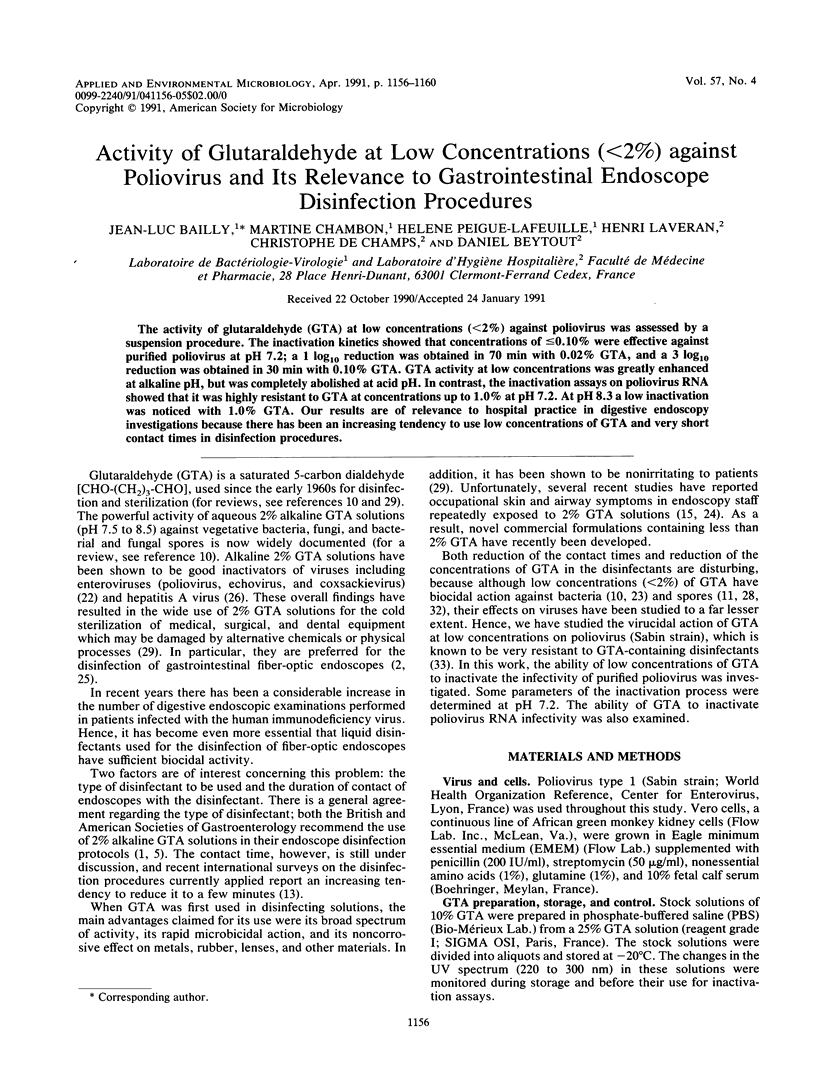
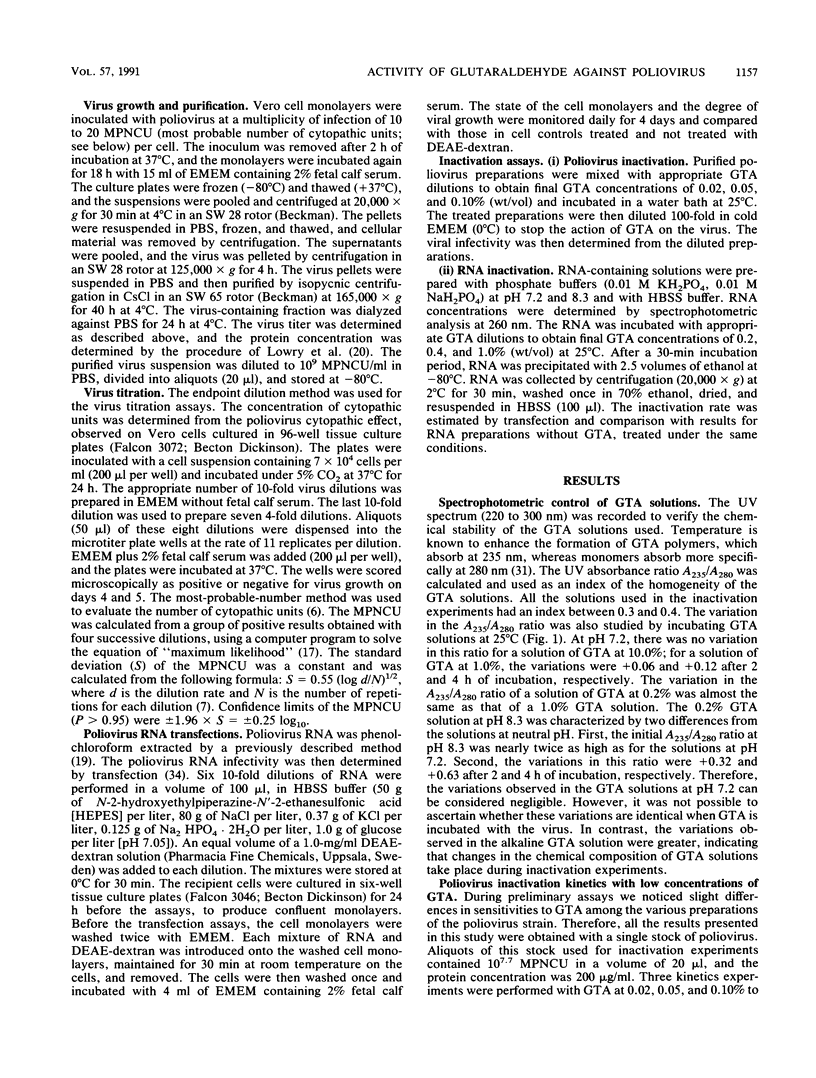
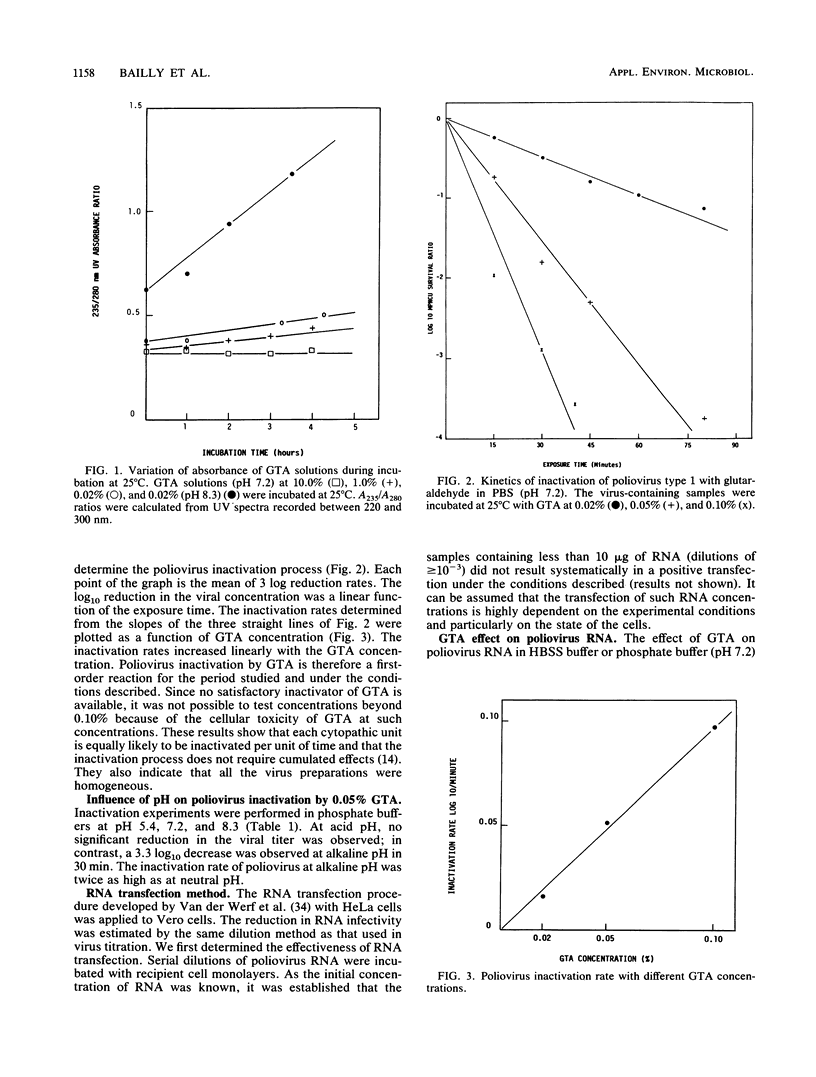
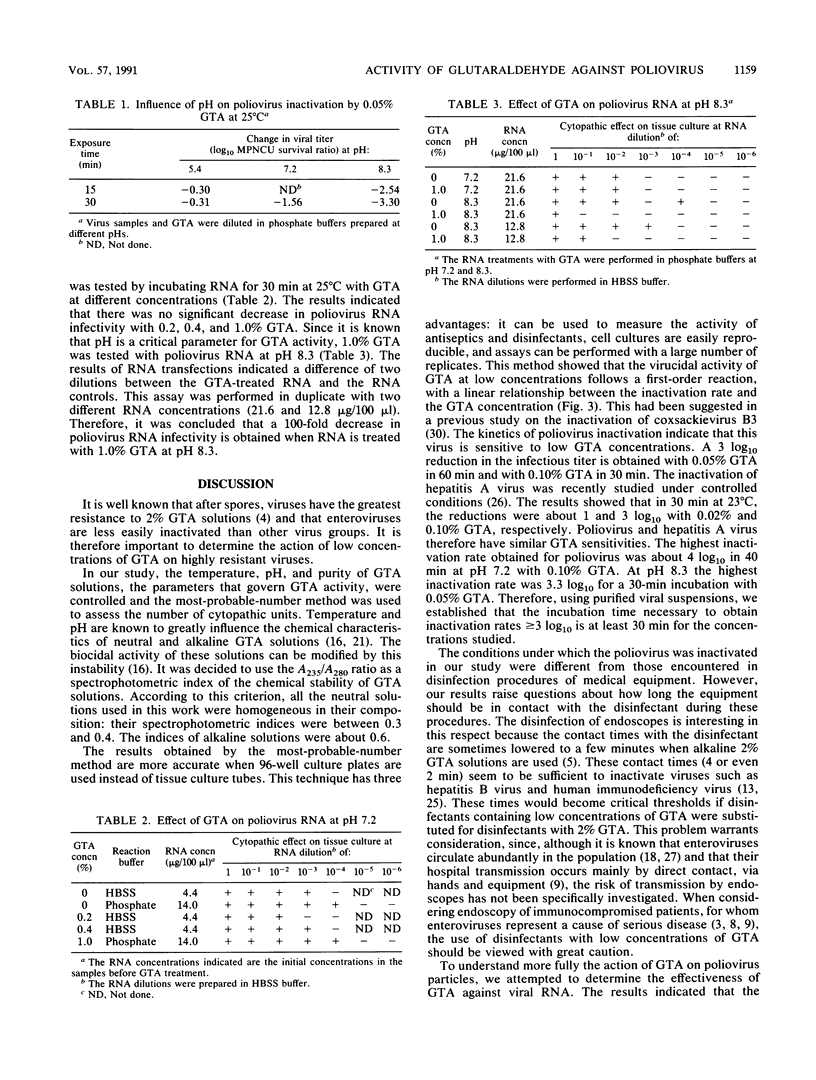
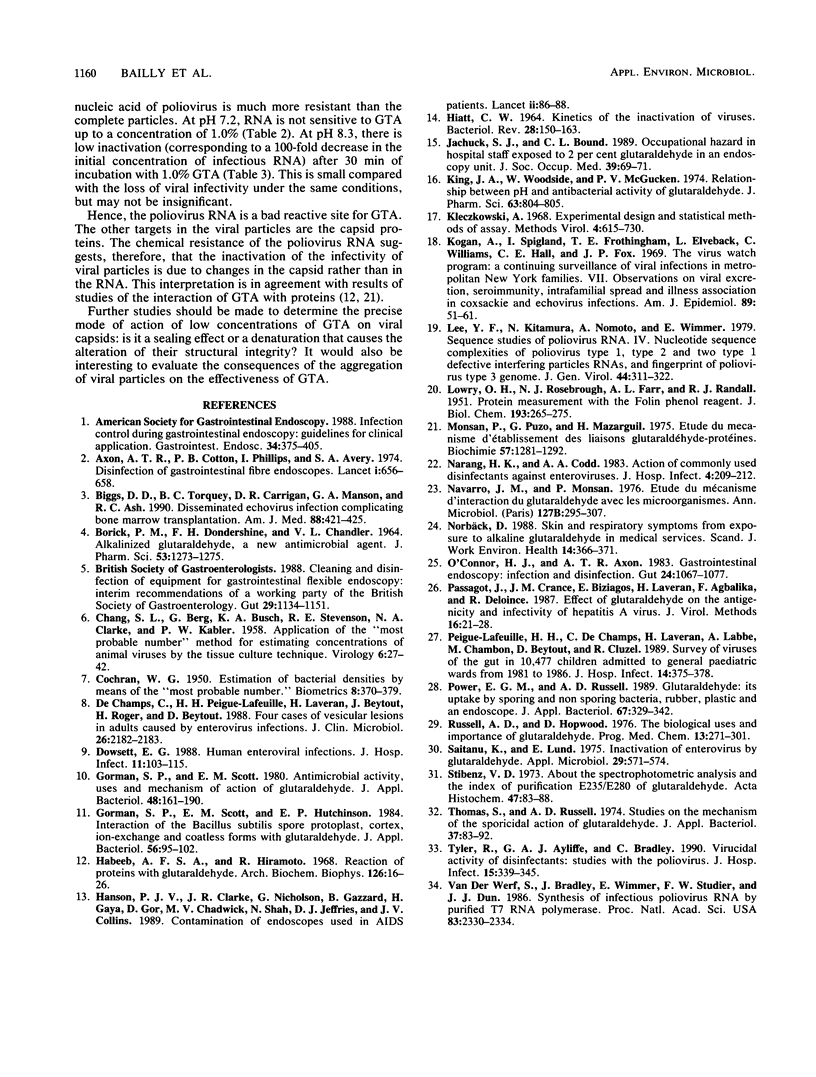
Selected References
These references are in PubMed. This may not be the complete list of references from this article.
- Axon A. T., Phillips I., Cotton P. B., Avery S. A. Disinfection of gastrointestinal fibre endoscopes. Lancet. 1974 Apr;1(7859):656–658. doi: 10.1016/s0140-6736(74)93202-4. [DOI] [PubMed] [Google Scholar]
- BORICK P. M., DONDERSHINE F. H., CHANDLER V. L. ALKALINIZED GLUTARALDEHYDE, A NEW ANTIMICROBIAL AGENT. J Pharm Sci. 1964 Oct;53:1273–1275. doi: 10.1002/jps.2600531041. [DOI] [PubMed] [Google Scholar]
- Biggs D. D., Toorkey B. C., Carrigan D. R., Hanson G. A., Ash R. C. Disseminated echovirus infection complicating bone marrow transplantation. Am J Med. 1990 Apr;88(4):421–425. doi: 10.1016/0002-9343(90)90501-4. [DOI] [PubMed] [Google Scholar]
- CHANG S. L., BERG G., BUSCH K. A., STEVENSON R. E., CLARKE N. A., KABLER P. W. Application of the most probable number method for estimating concentrations of animal viruses by the tissue culture technique. Virology. 1958 Aug;6(1):27–42. doi: 10.1016/0042-6822(58)90057-6. [DOI] [PubMed] [Google Scholar]
- Dechamps C., Peigue-Lafeuille H. H., Laveran H., Beytout J., Roger H., Beytout D. Four cases of vesicular lesions in adults caused by enterovirus infections. J Clin Microbiol. 1988 Oct;26(10):2182–2183. doi: 10.1128/jcm.26.10.2182-2183.1988. [DOI] [PMC free article] [PubMed] [Google Scholar]
- Dowsett E. G. Human enteroviral infections. J Hosp Infect. 1988 Feb;11(2):103–115. doi: 10.1016/0195-6701(88)90051-5. [DOI] [PubMed] [Google Scholar]
- Gorman S. P., Scott E. M., Hutchinson E. P. Interaction of the Bacillus subtilis spore protoplast, cortex, ion-exchange and coatless forms with glutaraldehyde. J Appl Bacteriol. 1984 Feb;56(1):95–102. doi: 10.1111/j.1365-2672.1984.tb04699.x. [DOI] [PubMed] [Google Scholar]
- Gorman S. P., Scott E. M., Russell A. D. Antimicrobial activity, uses and mechanism of action of glutaraldehyde. J Appl Bacteriol. 1980 Apr;48(2):161–190. doi: 10.1111/j.1365-2672.1980.tb01217.x. [DOI] [PubMed] [Google Scholar]
- HIATT C. W. KINETICS OF THE INACTIVATION OF VIRUSES. Bacteriol Rev. 1964 Jun;28:150–163. doi: 10.1128/br.28.2.150-163.1964. [DOI] [PMC free article] [PubMed] [Google Scholar]
- Habeeb A. J., Hiramoto R. Reaction of proteins with glutaraldehyde. Arch Biochem Biophys. 1968 Jul;126(1):16–26. doi: 10.1016/0003-9861(68)90554-7. [DOI] [PubMed] [Google Scholar]
- Hanson P. J., Gor D., Clarke J. R., Chadwick M. V., Nicholson G., Shah N., Gazzard B., Jeffries D. J., Gaya H., Collins J. V. Contamination of endoscopes used in AIDS patients. Lancet. 1989 Jul 8;2(8654):86–88. doi: 10.1016/s0140-6736(89)90323-1. [DOI] [PubMed] [Google Scholar]
- Jachuck S. J., Bound C. L., Steel J., Blain P. G. Occupational hazard in hospital staff exposed to 2 per cent glutaraldehyde in an endoscopy unit. J Soc Occup Med. 1989 Summer;39(2):69–71. doi: 10.1093/occmed/39.2.69. [DOI] [PubMed] [Google Scholar]
- King J. A., Woodside W., McGucken P. V. Letter: Relationship between pH and antibacterial activity of glutaraldehyde. J Pharm Sci. 1974 May;63(5):804–805. doi: 10.1002/jps.2600630538. [DOI] [PubMed] [Google Scholar]
- Kogon A., Spigland I., Frothingham T. E., Elveback L., Williams C., Hall C. E., Fox J. P. The virus watch program: a continuing surveillance of viral infections in metropolitan New York families. VII. Observations on viral excretion, seroimmunity, intrafamilial spread and illness association in coxsackie and echovirus infections. Am J Epidemiol. 1969 Jan;89(1):51–61. doi: 10.1093/oxfordjournals.aje.a120915. [DOI] [PubMed] [Google Scholar]
- LOWRY O. H., ROSEBROUGH N. J., FARR A. L., RANDALL R. J. Protein measurement with the Folin phenol reagent. J Biol Chem. 1951 Nov;193(1):265–275. [PubMed] [Google Scholar]
- Lee Y. F., Kitamura N., Nomoto A., Wimmer E. Sequence studies of poliovirus RNA. IV. Nucleotide sequence complexities of poliovirus type 1, type 2 and two type 1 defective interfering particles RNAs, and fingerprint of the poliovirus type 3 genome. J Gen Virol. 1979 Aug;44(2):311–322. doi: 10.1099/0022-1317-44-2-311. [DOI] [PubMed] [Google Scholar]
- Monsan P., Puzo G., Mazarguil H. Etude du mécanisme d'établissement des liaisons glutaraldéhyde-protéines. Biochimie. 1975 Nov-Dec;57(11-12):1281–1292. [PubMed] [Google Scholar]
- Narang H. K., Codd A. A. Action of commonly used disinfectants against enteroviruses. J Hosp Infect. 1983 Jun;4(2):209–212. doi: 10.1016/0195-6701(83)90052-x. [DOI] [PubMed] [Google Scholar]
- Navarro J. M., Monsan P. Etude du mécanisme d'interaction du glutaraldéhyde avec les microorganismes. Ann Microbiol (Paris) 1976 Oct;127B(3):295–307. [PubMed] [Google Scholar]
- Norbäck D. Skin and respiratory symptoms from exposure to alkaline glutaraldehyde in medical services. Scand J Work Environ Health. 1988 Dec;14(6):366–371. [PubMed] [Google Scholar]
- O'Connor H. J., Axon A. T. Gastrointestinal endoscopy: infection and disinfection. Gut. 1983 Nov;24(11):1067–1077. doi: 10.1136/gut.24.11.1067. [DOI] [PMC free article] [PubMed] [Google Scholar]
- Passagot J., Crance J. M., Biziagos E., Laveran H., Agbalika F., Deloince R. Effect of glutaraldehyde on the antigenicity and infectivity of hepatitis A virus. J Virol Methods. 1987 May;16(1-2):21–28. doi: 10.1016/0166-0934(87)90027-9. [DOI] [PubMed] [Google Scholar]
- Peigue-Lafeuille H. H., De Champs C., Laveran H., Labbe A., Chambon M., Beytout D., Cluzel R. Survey of viruses of the gut in 10,477 children admitted to general paediatric wards from 1981 to 1986. J Hosp Infect. 1989 Nov;14(4):375–378. doi: 10.1016/0195-6701(89)90080-7. [DOI] [PMC free article] [PubMed] [Google Scholar]
- Power E. G., Russell A. D. Glutaraldehyde: its uptake by sporing and non-sporing bacteria, rubber, plastic and an endoscope. J Appl Bacteriol. 1989 Sep;67(3):329–342. doi: 10.1111/j.1365-2672.1989.tb02502.x. [DOI] [PubMed] [Google Scholar]
- Russell A. D., Hopwood D. The biological uses and importance of glutaraldehyde. Prog Med Chem. 1976;13:271–301. doi: 10.1016/s0079-6468(08)70140-1. [DOI] [PubMed] [Google Scholar]
- Saitanu K., Lund E. Inactivation of enterovirus by glutaraldehyde. Appl Microbiol. 1975 May;29(5):571–574. doi: 10.1128/am.29.5.571-574.1975. [DOI] [PMC free article] [PubMed] [Google Scholar]
- Stibenz D. Uber die spektralphotometrische Gehaltsbestimmung und den Reinigungsindex E235-E280 von Glutaraldehyd. Acta Histochem. 1973;47(1):83–88. [PubMed] [Google Scholar]
- Thomas S., Russell A. D. Studies on the mechanism of the sporicidal action of glutaraldehyde. J Appl Bacteriol. 1974 Mar;37(1):83–92. doi: 10.1111/j.1365-2672.1974.tb00417.x. [DOI] [PubMed] [Google Scholar]
- Tyler R., Ayliffe G. A., Bradley C. Virucidal activity of disinfectants: studies with the poliovirus. J Hosp Infect. 1990 May;15(4):339–345. doi: 10.1016/0195-6701(90)90090-b. [DOI] [PubMed] [Google Scholar]
- van der Werf S., Bradley J., Wimmer E., Studier F. W., Dunn J. J. Synthesis of infectious poliovirus RNA by purified T7 RNA polymerase. Proc Natl Acad Sci U S A. 1986 Apr;83(8):2330–2334. doi: 10.1073/pnas.83.8.2330. [DOI] [PMC free article] [PubMed] [Google Scholar]


